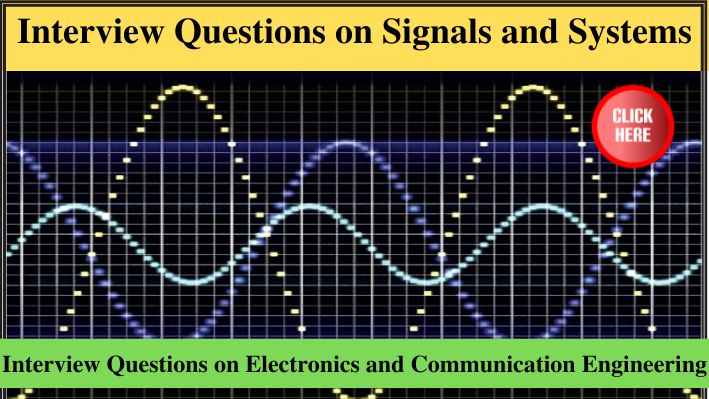Interview Questions on Signals and Systems
Interview Questions on Signals and Systems
Hello, In the blog, we will discuss Interview Questions on Signals and Systems, These questions are asked in many technical interviews, Feel free to ask doubts and suggestions on it.
Also read: Interview questions on Electronic devices and circuits
Interview questions on digital electronics
Interview questions on Network Analysis
Interview questions on Electronics and communication Engineering
Definition type questions
What is a signal?
Answer: A signal is a function that conveys information or represents a physical quantity.
What are the different types of signals?
Answer: There are four main types of signals: continuous, discrete, analog, and digital.
What is a system?
Answer: A system is a collection of components that work together to produce a desired output.
What is the difference between linear and nonlinear systems?
Answer: Linear systems have a constant relationship between input and output, while nonlinear systems have a varying relationship between input and output.
What is the impulse response of a system?
Answer: The impulse response of a system is the output of the system in response to a unit impulse input.
What is the transfer function of a system?
Answer: The transfer function of a system is the ratio of the Laplace transform of the output to the Laplace transform of the input.
What is convolution?
Answer: Convolution is a mathematical operation that represents the amount of overlap between two signals as a function of time.
What is the Fourier transform?
Answer: The Fourier transform is a mathematical tool that transforms a signal from the time domain to the frequency domain.
What is the Laplace transform?
Answer: The Laplace transform is a mathematical tool that transforms a signal from the time domain to the complex frequency domain.
What is a signal spectrum?
Answer: A signal spectrum is a representation of the frequency content of a signal.
What is the Nyquist rate?
Answer: The Nyquist rate is the minimum sampling rate needed to perfectly reconstruct a signal from its samples.
Some more definition-type questions
What is a digital filter?
Answer: A digital filter is a mathematical algorithm that processes digital signals to achieve a desired effect, such as smoothing or sharpening.
What is a Z-transform?
Answer: The Z-transform is a mathematical tool used to analyze and design discrete-time linear systems.
What is a differential equation?
Answer: A difference equation is a mathematical equation that describes the relationship between the input and output of a discrete-time system.
What is a state-space representation?
Answer: A state-space representation is a mathematical representation of a system that describes the internal states of the system, as well as the input-output relationship.
What is stability?
Answer: Stability refers to the property of a system to return to its initial state after a perturbation or disturbance.
What is causality?
Answer: Causality refers to the property of a system that the output only depends on the present and past inputs, and not on future inputs.
What is frequency response?
Answer: The frequency response of a system is the output-to-input relationship as a function of frequency.
What is a Bode plot?
Answer: A Bode plot is a graphical representation of the magnitude and phase response of a system as a function of frequency.
What is a filter design?
Answer: Filter design is the process of designing a digital filter to meet a set of specifications, such as stopband attenuation, passband ripple, and cutoff frequency.
What is the Fourier Transform Pair?
Answer: The Fourier transform pair is a mathematical relationship between a signal in the time domain and its frequency domain representation.
What is a Power Spectral Density (PSD)?
Answer: The Power Spectral Density (PSD) is a measure of the power content of a signal as a function of frequency, and it provides a frequency-domain representation of the signal’s power distribution.
Another 10 Interview questions on signals and systems
Here are 10 more interview questions and answers on signals and systems:
What is an impulse response of a linear time-invariant system?
Answer: The impulse response of a linear time-invariant (LTI) system is a unique representation of the system that completely characterizes its response to any input signal.
What is the difference between causality and stability?
Answer: Causality refers to the property of a system where the output only depends on present and past inputs and not on future inputs. Stability refers to the property of a system to return to its initial state after a perturbation or disturbance.
What is the difference between linear convolution and circular convolution?
Answer: Linear convolution is a mathematical operation that involves overlapping and adding two signals in the time domain, while circular convolution involves overlapping and adding two signals in the frequency domain.
What is a Fourier series?
Answer: A Fourier series is a mathematical representation of a periodic signal as an infinite sum of sine and cosine functions.
What is a Sampled Signal?
Answer: A sampled signal is a discrete-time signal obtained by measuring the values of a continuous-time signal at regular intervals of time.
What is the Sampling Theorem?
Answer: The Sampling theorem states that a continuous-time signal can be perfectly reconstructed from its samples if the sampling rate is greater than the Nyquist rate.
What is a Transfer Function?
Answer: The transfer function of a system is the ratio of the Laplace transform of the output to the Laplace transform of the input, and it characterizes the system’s frequency response.
What is an Eigenfunction?
Answer: An eigenfunction is a special type of function that, when transformed by a linear operator, only changes its magnitude but not its shape.
Difficult interview questions on signals and systems (Part-1)
Here are some difficult interview questions and answers on signals and systems:
What is the difference between system identification and system modeling?
Answer: System identification is the process of using measurement data to determine the mathematical representation of a system, while system modeling is the process of using prior knowledge and mathematical techniques to represent a system. System identification provides an empirical model of the system, while system modeling provides a theoretical model of the system.
What is the Z-Transform and what is its importance in signals and systems?
Answer: The Z-Transform is a discrete-time equivalent of the Laplace transform and it is used to study and analyze discrete-time signals and systems. It is important in signals and systems because it provides a tool for analyzing the stability, causality, and invertibility of discrete-time systems.
What is the role of state-space representation in control systems?
Answer: The state-space representation is a mathematical model of a control system that describes its behavior in terms of a set of first-order differential equations. The state-space representation is used in control systems because it provides a compact and convenient way to represent the system, and it can be used to analyze the stability, controllability, and observability of the system.
What is the Nyquist stability criterion?
Answer: The Nyquist stability criterion is a graphical method used to determine the stability of a feedback control system by examining the locations of the closed-loop poles in the complex plane. The criterion states that the system is stable if and only if all the closed-loop poles are in the left half of the complex plane.
Part-2:
What is the difference between minimum phase and non-minimum phase systems?
Answer: A minimum phase system is a system where all its poles and zeros are in the left half of the complex plane and it has no zeros on the jw axis. A non-minimum phase system is a system where some of its poles and zeros are in the right half of the complex plane or on the jw axis. Minimum phase systems are preferred in control systems because they are more stable and easier to control than non-minimum phase systems.
What is the Bode Plot and how is it used in control systems?
Answer: The Bode plot is a graphical representation of the magnitude and phase of a transfer function as a function of frequency. It is used in control systems to evaluate the stability, robustness, and performance of a control system in the frequency domain. The Bode plot provides a visual representation of the system’s behavior over a range of frequencies, making it easier to identify potential problems and design appropriate compensators.
What is the difference between the impulse response and the step response of a system?
Answer: The impulse response of a system is the response of the system to a unit impulse input, while the step response of a system is the response of the system to a unit step input. The impulse response provides information about the system’s response to a brief input, while the step response provides information about the system’s response to a change in the input level.
Part-3:
What is the difference between the convolution sum and the convolution integral?
Answer: The convolution sum is a discrete-time equivalent of the convolution integral, which is used to calculate the output of a linear time-invariant system given its input and impulse response. The convolution sum involves summing the product of the input and the impulse response over discrete time intervals, while the convolution integral involves integrating the product of the input and the impulse response over continuous time intervals.
What is the relationship between the Laplace Transform and the Fourier Transform?
Answer: The Laplace Transform and the Fourier Transform are two powerful mathematical tools used to study and analyze signals and systems. The Laplace Transform is used to study continuous-time signals and systems, while the Fourier Transform is used to study discrete-time signals and systems. The relationship between the two transforms is that the Laplace Transform can be viewed as a continuous-time equivalent of the Fourier Transform, and the Fourier Transform can be viewed as a discrete-time equivalent of the Laplace Transform.
What is the difference between linear time-invariant (LTI) systems and non-linear time-invariant (LTV) systems?
Answer: Linear time-invariant (LTI) systems are systems where the input-output relationship is linear and time-invariant. Non-linear time-invariant (LTV) systems are systems where the input-output relationship is non-linear and/or time-varying. LTI systems are easier to analyze and design than LTV systems, as the properties of linearity and time-invariance allow for the use of powerful mathematical tools such as the Laplace Transform and the Fourier Transform. However, many real-world systems are non-linear and time-varying, making LTV systems more challenging to analyze and design.
Part-4:
What is the relationship between the impulse response and the transfer function of a system?
Answer: The impulse response of a system is related to the transfer function of the system through the convolution integral. The transfer function is the Laplace Transform of the impulse response and it provides a compact representation of the system’s behavior in the frequency domain. The impulse response and transfer functions are dual to each other, meaning that they provide complementary information about the system.
What is the difference between stability and causality in signals and systems?
Answer: Stability in signals and systems refers to the property of a system where its output remains bounded for all bounded inputs, and it does not grow unbounded over time. Causality, on the other hand, refers to the property of a system where the output depends only on the present and past inputs and not on future inputs. A system can be stable but not causal, or it can be causal but not stable. In control systems, it is important to have both stability and causality for proper operation.
What is the difference between time-domain and frequency-domain analysis in signals and systems?
Answer: Time-domain analysis is the study of signals and systems in the time domain, where the input and output signals are analyzed as a function of time. The frequency-domain analysis is the study of signals and systems in the frequency domain, where the input and output signals are analyzed as a function of frequency. Time-domain analysis provides a visual representation of the system’s behavior over time, while frequency-domain analysis provides a visual representation of the system’s behavior over a range of frequencies. Both time-domain and frequency-domain analysis have their own advantages and disadvantages.
Part-5:
What is the Sampling Theorem and how is it used in signals and systems?
Answer: The Sampling Theorem states that a continuous-time signal can be perfectly reconstructed from its samples if the sampling rate is greater than twice the maximum frequency of the signal. The Sampling Theorem is used in signals and systems to convert continuous-time signals into discrete-time signals, which can then be processed and analyzed using discrete-time techniques. The Sampling Theorem is important because it provides a theoretical foundation for the design of digital signal processing systems.
What is the relationship between the transfer function and the frequency response of a system?
Answer: The transfer function and the frequency response of a system are closely related and provide complementary information about the system. The transfer function provides a compact representation of the system’s behavior in the frequency domain, while the frequency response provides a visual representation of the system’s behavior over a range of frequencies. The frequency response can be obtained from the transfer function by evaluating it at a range of frequencies, and it provides a way to visualize the system’s behavior in the frequency domain.
For more interview questions, Visit our main website Digital Tech Fact



